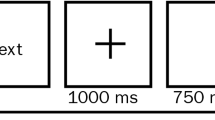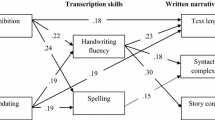Abstract
In an effort to provide some expectation regarding the influences of task and rehearsal, the narrative ability of 20 normal young adults was examined under the conditions of story retelling and story generation. Each task was repeated after a 1-week interval in order to investigate a possible practice effect. Sentence production, intersentential cohesion, and story grammar organization were analyzed. Results indicated that the subjects' performance varied as a function of task presentation as well as the measure used to describe narrative production. The only across-trials difference noted was an increase in cohesive adequacy from trial 1 to trial 2 for one of the story generation tasks. It may be concluded that (a) context does influence the manner and competence of narrative presentation, and (b) that rehearsal of a complex narrative improves narrative coherence.
Similar content being viewed by others
References
Bottenberg, D., Lemme, M. L., & Hedberg, N. (1985). Analysis of oral narratives of normal and aphasic adults. In R. H. Brookshire (Ed.),Clinical Aphasiology: Conference proceedings (pp. 241–247). Minneapolis: BRK Publishers.
Bruning, J. L., & Kintz, B. L. (1968).Computational handbook of statistics. Glenview, IL: Scott, Foresman & Co.
Ernest-Baron, C. R., Brookshire, R. H., & Nicholas L. E. (1987). Story structure and retelling narratives by aphasic and non-brain-damaged adults.Journal of Speech and Hearing Research, 30, 44–49.
Garber, M. (1979).An examination and comparison of selected cohesive features found in child-produced texts and beginning reading materials. Unpublished doctoral dissertation, Georgia State University.
Gardner, H., Brownell, H. H., Wapner, W., & Michellow, D. (1983). Missing the point: The role of the right hemisphere in the processing of complex linguistic materials. In E. Perecman (Ed.),Cognitive processing in the right hemisphere (pp. 169–191). New York: Academic Press.
Halliday, M. A. K., & Hasan, R. (1976).Cohesion in English. London: Longman.
Hunt, K. (1970). Syntactic maturity in school children and adults.Monographs of the Society for Research in Child Development, 35 (Serial No. 134).
Lemme, M. L., Hedberg, N., & Bottenberg, D. E. (1984). Cohesion in naratives of aphasic adults. In R. H. Brookshire (Ed.),Clinical aphasiology: Conference proceedings (pp. 215–222). Minneapolis: BRK Publishers.
Liles, B. Z. (1985). Narrative ability in normal and language disordered children.Journal of Speech and Hearing Research, 28, 123–133.
Liles, B. Z. (1987). Episode organization and cohesive conjunctives in narratives of children with and without language disorder.Journal of Speech and Hearing Research, 30, 185–196.
Liles, B. Z., Coelho, C. A., Duffy, R. J., & Zalagens, M. R. (1989). Effects of elicitation procedures on the narratives of normal and closed head injured adults.Journal of Speech and Hearing Disorders, 54, 356–366.
Mackisack, E. L., Myers, P. S., & Duffy, J. R. (1987). Verbosity and labeling behavior: the performance of right hemisphere and non-brain-damaged adults on an inferential picture description task. In: R. H. Brookshire (Ed.),Clinical aphasiology: Conference proceedings (pp. 143–151). Minneapolis: BRK Publishers.
Mentis, M., & Prutting, C. A. (1987). Cohesion in the discourse of normal and headinjured adults.Journal of Speech and Hearing Research, 30, 88–98.
Merritt, D. D., & Liles, B. Z. (1987). Story grammar ability in normal and language disordered children: Story generation, story retelling, and story comprehension.Journal of Speech and Hearing Research, 30, 539–552.
Milton, S. B., Prutting, C. A., & Binder, G. M. (1984). Appraisal of communicative competence in head injured adults. In R. H. Brookshire (Ed.),Clinical, aphasiology: Conference proceedings (pp. 114–123). Minneapolis: BRK Publishers.
Pappas, C. (1981).The development of narrative capabilities within a synergistic, variable perspective of language development: An examination of cohesive harmony of stories produced in three contexts-retelling, dictation and writing. Unpublished doctoral dissertation, The Ohio State University.
Rivers, D., & Love, R. (1980). Language performance on visual processing tasks in right hemisphere lesion cases.Brain and Language, 10, 348–366.
Stein, N. L. (1982). The definition of a story.Journal of Pragmatics, 6, 487–507.
Stein, N. L., & Glenn, C. G. (1979). An analysis of story comprehension in elementary school children. In R. O. Freedle (Ed.),New Directions in Discourse Processing (Vol. II) (pp. 53–120). Norwood, NJ: Ablex.
Trupe, E., & Hillis, A. (1985). Paucity vs. verbosity: Another analysis of right hemisphere communication deficits. In R. H. Brookshire (Ed.),Clinical aphasiology: Conference proceedings (pp. 83–92). Minneapolis: BRK Publishers.
Ulatowska, H., Freedman-Stern, R., Doyel, A., Macaluso-Haynes, S., & North, A. (1983). Production of narrative discourse in aphasia.Brain and Language, 19, 317–334.
Ulatowska, H. K., North, A. J., & Macaluso-Haynes, S. (1981) Production of narrative and procedural discourse in aphasia.Brain and Language, 17, 345–371.
Uryase, D. (1988).Analysis and description of narrative discourse in right hemisphere-damaged adults: A comparison to neurologically normal and left hemisphere-damaged adults. Unpublished doctoral dissertation, University of Connecticut.
Uryase, D., Coelho, C. A., Liles, B. Z., & Duffy, R. J. (1984, November).Narrative discourse in aphasic and right-hemisphere-injured adults. Paper presented at the annual convention of the American Speech-Language-Hearing Association, San Francisco.
Wapner, W., Hamby, S., & Gardner, H. (1981). The role of the right hemisphere in the apprehension of complex linguistic materials.Brain and Language, 14, 15–33.
Wegner, M., Brookshire, R., & Nicholas, L. (1984). Comprehension of main ideas and details in coherent and noncoherent discourse by aphasic and nonaphasic listeners.Brain and Language, 21, 37–51.
Winter, P. (1976).The bear and the fly. New York: Crown Publishers.
Wycoff, L. H. (1984).Narrative and procedural discourse following closed head injury. Unpublished doctoral dissertation, University of Florida.
Author information
Authors and Affiliations
Rights and permissions
About this article
Cite this article
Coelho, C.A., Liles, B.Z. & Duffy, R.J. Contextual influences on narrative discourse in normal young adults. J Psycholinguist Res 19, 405–420 (1990). https://doi.org/10.1007/BF01068887
Accepted:
Issue Date:
DOI: https://doi.org/10.1007/BF01068887




